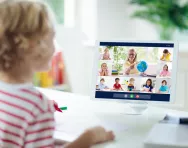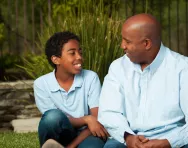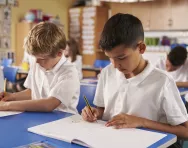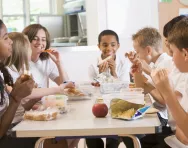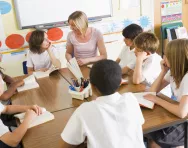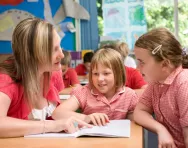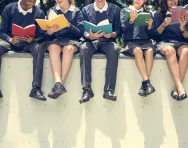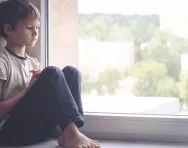Important update from TheSchoolRun
For the past 13 years, TheSchoolRun has been run by a small team of mums working from home, dedicated to providing quality educational resources to primary school parents. Unfortunately, rising supplier costs and falling revenue have made it impossible for us to continue operating, and we’ve had to make the difficult decision to close. The good news: We’ve arranged for another educational provider to take over many of our resources. These will be hosted on a new portal, where the content will be updated and expanded to support your child’s learning.
What this means for subscribers:
- Your subscription is still active, and for now, you can keep using the website as normal — just log in with your usual details to access all our articles and resources*.
- In a few months, all resources will move to the new portal. You’ll continue to have access there until your subscription ends. We’ll send you full details nearer the time.
- As a thank you for your support, we’ll also be sending you 16 primary school eBooks (worth £108.84) to download and keep.
A few changes to be aware of:
- The Learning Journey weekly email has ended, but your child’s plan will still be updated on your dashboard each Monday. Just log in to see the recommended worksheets.
- The 11+ weekly emails have now ended. We sent you all the remaining emails in the series at the end of March — please check your inbox (and spam folder) if you haven’t seen them. You can also follow the full programme here: 11+ Learning Journey.
If you have any questions, please contact us at [email protected]. Thank you for being part of our journey it’s been a privilege to support your family’s learning.
*If you need to reset your password, it will still work as usual. Please check your spam folder if the reset email doesn’t appear in your inbox.
Safeguarding in primary schools explained
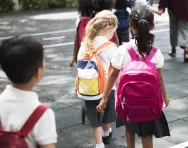
Every child has the right to be safe, whether that’s at home, at school, in out-of-school clubs or with other people, such as grandparents. And for the most part, everyone involved in the care of children has their best interests at heart, and wants them to be happy and healthy.


Start a unique learning programme!
- Weekly programme for each school year
- Worksheets sent direct to your inbox
- Keeps your child's learning on track
In some cases, though, there may be concerns about the wellbeing of a child, which is where safeguarding – the act of protecting children from harm and promoting their welfare and human rights – comes in.
Safeguarding is often informally described as three Ps:
- Protecting children from maltreatment.
- Preventing impairment of their health and/or development.
- Providing safe and effective care.
Schools and safeguarding
‘Schools play an essential role in protecting children, as teachers and other education staff have a lot of contact with young people so are well placed to spot the signs of abuse and neglect,’ explains Sarah Ward, NSPCC Safeguarding Quality and Assurance Consultant.
‘Schools can help protect pupils by creating a safe environment through robust safeguarding practices, and ensuring all staff and volunteers don’t pose a risk to children. It’s vital that they also teach children about staying safe, and make sure they feel confident to approach a member of staff if they have a worry or problem.’
How are school staff trained in safeguarding?
By law, all staff working in a school must have safeguarding training. ‘It supports adults who are responsible for children, such as teachers, to identify the signs of abuse and neglect and ensure the necessary steps are taken to keep children safe,’ says Sarah.
This includes training on specific areas, such as identifying children who may be at risk of radicalisation (also known as Prevent training), female genital mutilation, and sexual exploitation.
Training can be either face-to-face or online. ‘The NSPCC has a range of online courses and resources, for example an e-learning course on child protection which aims to develop and refresh the knowledge of staff members working in schools so they can continue to keep the children that they work with safe,’ Sarah says.
Schools must also appoint a Designated Safeguarding Lead (DSL): a senior staff member who has overall responsibility for child protection issues. The DSL must have refresher training every two years.
What is Safer Recruitment?
Safer Recruitment is a key part of safeguarding and ensures that people who apply to work in a school are vetted for their suitability to work with children. It encompasses a number of checks, including an enhanced Disclosure and Barring Service (DBS) check which looks at things like criminal convictions and police cautions.
At least one person on every school interview panel must have had Safer Recruitment training.
Do I need safeguarding training to volunteer in a school?
The decision about whether volunteers should have safeguarding training and/or a DBS check lies partly with each school, and is usually based around how much contact a volunteer will have with children, and whether it’s supervised or non-supervised.
For example, a parent who volunteers to help on a school trip, comes into school to do a one-off talk in assembly, or helps sell cakes at a cake sale is unlikely to be unsupervised, and therefore not need safeguarding training or a DBS check.
However, a parent who comes into school regularly to listen to children read outside the classroom without supervision, or who accompanies children getting changed for swimming lessons, will very probably need an enhanced DBS check.
All school governors must also have an enhanced DBS check.
What are the signs of a safeguarding concern?
‘The signs that a child is being abused or neglected are not always immediately obvious,’ explains Sarah. ‘There are also different types of abuse – physical, sexual, emotional, neglect and domestic abuse – which mean these signs may vary.’
However, some common signs that there may be something concerning happening in a child’s life include:
- Unexplained changes in behaviour or personality
- Becoming withdrawn
- Seeming anxious
- Becoming uncharacteristically aggressive
- Lacking social skills and having few friends, if any
- Having a poor bond or relationship with a parent
- Having knowledge of adult issues inappropriate for their age
- Running away or going missing
- Always choosing to wear clothes which cover their body
‘These signs don’t necessarily mean that a child is being abused, and there could be other things happening in their life that are affecting their behaviour,’ Sarah says.
‘However, if any adult is concerned about a child and notices these signs, it’s important that they take action.’
What should I do if I’m concerned about another child?
‘Any parent, carer or professional who is concerned about a child and wants advice or guidance can call the NSPCC helpline (0808 800 500),’ Sarah advises. ‘One of our trained professionals can talk to you and provide you expert advice and support. It’s completely free, and adults can call anonymously.’
You can also talk to your child’s school if you have a safeguarding concern about another child. You can approach the DSL directly, or any another member of staff, who then has a responsibility to respond by referring it to the DSL.
It’s your right to raise a concern in confidence, and the school shouldn’t reveal your identity.
What will happen if a safeguarding concern is raised around my child?
It can be very distressing if a safeguarding concern is raised about your child, but it’s important to bear in mind that children’s services (social services) want to do everything they can to keep families together.
If a referral is made, children’s services have 24 hours to decide what action needs to be taken, such as whether an assessment should be made.
In some cases, all that will happen is that a social worker will have a phone conversation with you to discuss the nature of the referral and any next steps needed. This may be enough to reassure the social worker, and the case may be closed.
Sometimes, though, an assessment is required, which must take place within 45 days of the referral. It’s usually done by a social worker, and will involve:
- A family visit at home to discuss the allegations.
- An interview with your child/ren, away from the family (e.g. in another room).
- Liaising with other professionals who are involved with your child/family, such as their teacher and GP.
- Assessing the child’s developmental needs.
- Assessing the family’s ability to meet the child’s needs.
- Considering the impact of factors such as family history, health issues and housing issues on the child.
Following the assessment, if it’s determined that your child is not ‘in need,’ the case will be closed. If your child is deemed to be in need, children’s services will continue to be involved, for example by drawing up a plan to support the family.
Only in extreme circumstances, where there’s risk of significant harm, is immediate protection required (such as entrusting the child to a relative or to foster care).
Why can’t I post photos of my child’s school play on social media?
‘It’s important that children and young people feel happy with their achievements, and we know family and friends also want to share these moments, perhaps on social media,’ says Sarah.
However, many schools forbid parents and carers from taking photos or video of events such as school plays, prize-giving and sports days.
‘Sharing images of children on social media comes with its risks, and some children, parents or carers may not be comfortable with images being shared,’ Sarah explains. ‘One of these risks includes children being more vulnerable to grooming, and images being downloaded and shared by people not known to the families.’
Another is that a child may be in care, and would be at risk if their family knew which school they were attending.
For reasons like these, some schools have a ban on images being shared on social media, or even a blanket ban on photos and videos being taken at all.
‘All schools should have a written photography policy statement that details its overall approach to images taken of children during events and activities,’ Sarah explains. ‘It’s important that all children, parents and staff understand this and know how photos and films taken at school events can be shared safely.’
It’s your right to see this policy, and it’s common practice for a staff member to remind parents not to take photos at the start of a school event.
If your child’s school doesn’t have a formal photography and filming policy statement, the NSPCC has a template that schools can tailor. This can be found on NSPCC Learning.
Any parent, carer or professional who is concerned about a child and wants advice or guidance can call the NSPCC helpline on 0808 800 500 for expert advice and support. If you believe a child is in immediate danger, you should call 999. All reports can be anonymous.
‘I started panicking that we’d lose our children’
Trigger warning: mentions of suicide.
'Our family was the subject of an anonymous safeguarding referral after a parent from my son’s school reported that he had been talking about suicide. It was a huge shock: we’d never heard him mention it at home, and his teacher hadn’t said anything, either.
'We considered ourselves good parents, but I started panicking that something was terribly wrong with our son, and that we’d end up losing our children.
'Once we’d been notified of the referral by letter, an appointment was made for a social worker to visit us at home. I was really anxious, especially as we were told she’d want to look at the children’s bedrooms, and spent hours cleaning every inch of the house.
'When the social worker visited, she did her best to put us at ease, and told us the purpose of her visit was to see if we, or our children, needed any support, and not to take them away from us.
'She explained the nature of the complaint; apparently, my son had said he was going to kill himself after becoming upset during a playground game. It was difficult to hear, but equally, we were fairly confident that it was a knee-jerk reaction to someone being mean to him.
'The social worker asked lots of questions about our home and family life, our work, our own mental and physical health, our support network, and any difficulties we were having with parenting. It was quite intrusive, but she was kind and respectful and took the time to explain everything.
'The hardest part was that she had to talk to our children – aged 11 and five – in private. We knew we had nothing to hide, but it was still unsettling.
'At the end of her visit, the social worker implied that she had no concerns, but told us that she also needed to speak to the school and GP. A couple of weeks later, we were sent a copy of the full report – I could have kissed the children’s teachers, who spoke of happy, healthy kids and caring, attentive parents – and confirmation that the case was closed.
'I still wonder who reported us. Part of me recognises that it was the right thing to do, but I wish they’d spoken to me first. It’s made me wary of trusting other parents. Overall, though, while it was an upsetting experience, the referral was handled with sensitivity and kindness, and I felt reassured that they wanted to help rather than whisking our children away.'
Anonymous, mum to a son in Year 6 and a daughter in Year 1
